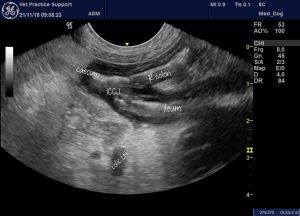It’s not surprising that dogs with acute pancreatitis often have signs of colitis!
Just a little image of interest…to show how closely the pancreas is associated with the transverse and descending left colon in the dog. And how the colon is enveloped within the resulting swamp of inflamed fat when the pancreas is poorly.
And a still image of the very inflamed-looking ileo-caeco-colic junction from the same patient:

The colon wall is diffusely thickened and the patient does indeed have faecal tenesmus and is passing small volumes of bloody, mucoid diarrhoea.
My guess is that this is just the direct effect of inflammatory mediators on the gut wall. An alternative would be that pancreatitis has been associated with reduced proteolytic enzyme release and this in turn may reduce resistance to clostridial enterocolitis:
‘….the well-recognized association of haemorrhagic gastroenteritis with small breed dogs may be explained by the increased incidence of pancreatitis in small rather than in large breed dogs, since pancreatitis will disrupt pancreatic trypsin production. By analogy, fatal type C C. perfringens enteritis has commonly been associated with trypsin inhibition by foods such as cassava, or by trypsin inhibitory factors in colostrum, with the consequence that CPB toxin produced in the small intestine is not destroyed by the proteolytic action of trypsin but rather initiates intestinal necrosis and cascading clostridial disease.’
A quote from:
PLoS One. 2015 Apr 8;10(4):e0122684. doi: 10.1371/journal.pone.0122684. eCollection 2015.
A novel pore-forming toxin in type A Clostridium perfringens is associated with both fatal canine hemorrhagic gastroenteritis and fatal foal necrotizing enterocolitis.
Mehdizadeh Gohari I1, Parreira VR1, Nowell VJ1, Nicholson VM1, Oliphant K1, Prescott JF1.
https://www.ncbi.nlm.nih.gov/pmc/articles/PMC4390311/





